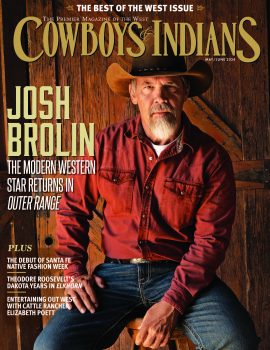Once featured on Texas' Most Endangered Places list by Preservation Texas and destined for demolition, the Magnolia Hotel has now been rescued.
Jim and Erin Ghedi, the owners of the Magnolia Hotel in Seguin, Texas, happened to stumble across an amateur video created by the Seguin Main Street Program pleading for someone to save their city’s first hotel and original stagecoach station from further vandalism and damage. Though seeking only a small building to restore as a retirement hobby, once the couple stepped through the door of the dilapidated old building, it was love at first sight. With the building’s vast Texas history and the couple's experience in restoration and historical and genealogical research, they knew they were the right people to take on the daunting challenge of saving this building.
The building began in 1839 as a simple two-room log cabin with a dog-trot built by Texas Ranger James Campbell. Campbell was a member of the Gonzales Militia of Mounted Rangers, who helped guard the early settlers against Indian attacks. He then fought in the Texas Revolution, when colonists in the Mexican province of Texas sought independence from the Mexican government. He also helped guard San Antonio during the Council House Fight with the Comanches in 1840.
Soon after the Texas Revolution, the burned-out and struggling small communities could not support the vast influx of new settlers heading into Texas. It was clear that more cities would be needed. Familiar with the area known as Walnut Springs, which was a favorite campground for Rangers while out scouting, Campbell purchased land there. Along with his Texas Ranger Captain, Matthew Caldwell, and Arthur Swift, Campbell founded the new community of Walnut Springs, which later had to change its name. James Campbell and John King suggested the town be named Seguin in honor of the Texas patriot and hero Juan Seguin.
The wood used to build his log cabin was actually designated for the town’s fort, but when deemed not necessary, it was sold to Campbell. The bark from these logs are still visible under the building, as are the pegs used for stabling. Campbell didn't live there long because he was attacked and killed by two Comanche Indians one mile outside of San Antonio on June 18, 1840. His friends and companions buried him at the site of his attack.
His two-room, dog-trot cabin in Seguin was then purchased and became the first stagecoach stop for the village of Seguin. The original three-room hotel was then built in 1844 behind the stagecoach station out of a solution known as Park’s Concrete. This hotel was also used as a wedding chapel where many well-known Texans were married, such as the famous Texas Ranger Captain John “Jack” Coffee Hays. Hays married his beloved Susan Calvert in 1847 as her father (the owner of the Magnolia Hotel) conducted the ceremony.
The hotel became one of the stopping points for many brave Texas Rangers who protected the settlers of Texas. The most recognizable name was Hays’ closest friend, William “Big Foot” Wallace. These two men fought alongside each other during the Battle of Salado Creek and remained friends for life.
In 1848, a large shelter was dug out under the stagecoach station by slave laborers to be used as an Indian raid shelter. It served as a safe place for the women and children whenever the men were called to fight against raiding Comanches. This shelter was also used as the city’s first jail until one could be built nearby. The remnants of the bars on the windows and latches for the cells are still visible. The famous hanging tree was located just across the street, where it was used during Texas’ days of lawlessness, most notably by Captain Hays. Hays hanged several Comanche braves, runaway slaves, and others who he believed violated his laws.
The building changed hands in 1850, and the two-story wooden section was added in the middle combining all three buildings into what is now recognized as the Magnolia Hotel. The building was built with slave labor and local frontier materials. Over the following years, the hotel served as a gathering place for the town to share local news with one another, as there was no town newspaper. It became the hub of social gatherings and known for gala events, and was considered the finest hotel in Texas.
During the hotel's heyday, it also came into possession of the actual Alamo Bell. The bell hung in front of the building for years announcing the arrival of the stagecoaches. It wasn’t until the Daughters of the Republic of Texas discovered it that it was returned to the Alamo.
The hotel’s most famous frequent visitor was Governor "Ox Cart" John Ireland. His daughter, Matilda Ireland, married Evan Shelby, the son of the hotel's owner, and the couple ran the hotel at the time. Governor Ireland fought hard to bring the railroad to Seguin and won. When the railroad finally made its way to town, the Governor made a grand speech on the hotel’s front balcony and an elegant celebration was held inside the Magnolia Hotel. Special plates were made for the event and are displayed in the Seguin-Guadalupe County Heritage Museum.
The hotel was able to survive the horrific Civil War years, but it experienced hard times when the Union soldiers made their way to Seguin during the Reconstruction Era. Just across the street, the Union soldiers made their camp. Union officers seized the hotel for their base and soldiers commandeered the Indian raid shelter for additional lodging. Many Union soldier bullets have been uncovered on the property. It is has been discovered that President Ulysses S. Grant lodged at the Magnolia Hotel when he led the army's supervision of Reconstruction in the former Confederate states. After surviving the intrusion of the Reconstruction Era, the hotel once again flourished as a grand establishment during the 1880s.
It wasn’t until 1910 that it became a boarding house and new hotels were constructed in the area. The hotel changed hands many times, and in 1927 it was sold to the Lannoms, who turned the hotel into an apartment complex and home to their family. After the Lannoms passed away, it remained vacant for 20 years and became a target for vandals, graffiti artists, and drug users. But now, after being considered for demolition, this Texas landmark has been saved. Nine wars and 38 presidents after it was built, this historic hotel still survives and is being restored back to its 1880s luster.













